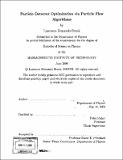Particle detector optimization via particle flow algorithms
Author(s)
Bronk, Lawrence Fernando
DownloadFull printable version (10.10Mb)
Other Contributors
Massachusetts Institute of Technology. Dept. of Physics.
Advisor
Peter Fisher.
Terms of use
Metadata
Show full item recordAbstract
Using the the SLIC simulator software and the org.lcsim reconstruction framework package, the performance of Mat Charles' NonTrivialPfa.java PFA for several different detector variations was found by determining the mass resolution for a given detector geometry. The variations tested included the layering of the hadronic calorimeter, the radius of the calorimeter, the interaction material utilized in the hadronic calorimeter and the type of read-out used in the calorimeter. Based on the performance of the PFA for the different variations, the optimal detector specifications for use with the PFA were discovered. The optimal detector was found to use scintillator as the sensitive layer and steel as the interaction material in the hadronic calorimeter. A general trend in increased performance with more layering was also observed for the calorimeter. Also illuminated in the study was the discovery of unexpected performance for radius variations.
Description
Thesis (S.B.)--Massachusetts Institute of Technology, Dept. of Physics, 2008. Includes bibliographical references (p. 51).
Date issued
2008Department
Massachusetts Institute of Technology. Department of PhysicsPublisher
Massachusetts Institute of Technology
Keywords
Physics.